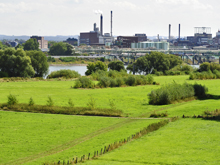Noise in the environment of an industrial site is a problem in different contexts:
- in case of exceeding of the admissible limit for emergence: this is the difference between the A-weighted equivalent continuous pressure levels of the ambient noise - considered industrial site considered in operation - and of the residual noise - in the absence of noise generated by the considered industrial site, but measured over its operating period) in zones with regulated emergence (ZRE); depending on the context: 5 or 6 dB(A) during the day and 3 or 4 dB(A) during the night
- in case of presence of a tonal component: when, considering an unweighted third-octave spectrum due to the operation of the indtsrial site, the level in a frequency band exceeds by 5 dB or more the average level of the two adjacent frequency bands from 400 Hz to 6300 Hz or 10 dB that of the two adjacent frequency bands from 63 to 315 Hz
- in case of exceeding the permissible level at the property boundary, set by prefectural decree - typically 70 dB(A) during the day, 60 dB(A) during the night -
|
measure and study environmental noise for industrial sites, carry out a diagnosis and propose solutions is at the heart of ITS activty |
The disadvantages inherent in such situations include:
- for the neighborhood (depending on the case: at the property boundary or at a greater distance): a threat to peace, during the appearance of particular noises linked to the facilities and equipment of the incriminated industrial site due to their duration, their repetition or their intensity
- for the company causing the nuisance: recriminations, complaints (including sometimes with a legal aspect), formal notices, and an obligation to remedy the disturbances caused, conditioning the maintenance of some activities
In addition to this, exceeding (compared to a specification) the noise levels emitted by equipment or facility delivered, for a given industrial site, by a supplier also constitutes an undesirable context since it constitutes a breach of a contractual obligation that may cause a lot of inconvenience.
ITS carries out environmental noise measurement and study, offering diagnosis and solutions. All ITS activities in this area (major, long-standing), are regularly assessed in accordance with the requirements of the ISO 9001 standard (relating to quality management systems).
Environmental noise measurement, diagnosis
ITS performs environmental noise measurements and diagnoses:
- to check compliance with regulations or specifications
- (in the case where the sound levels measured are beyond the authorized limits, thus potentially constituting an annoyance or at the very least a disorder) to identify the main sources of noise, and prioritize them (as to their impact, in terms of sound levels, at specified locations)
Such metrology for the determination of indicators having to do with the sound pressure level are carried out on site (day and night, weekdays and weekends and during holidays):
- by a human resource duly graduated in physical measurements (qualified in instrumental techniques) experienced in the requirements and specificities of noise measurements
- with measurement hardware subject to periodic checks and calibrations (more information relating to ITS acoustic measurement means e.g. sound level meter, calibrator, data processing software)
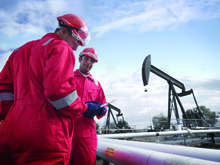
Among others, ITS offers noise measurement and study, diagnostics and solutions in the energy sector |
Environmental noise measurements allow to check the conformity of a facility and, when required, base the search for improving acoustical situation. |
Environmental noise in the environment and a diagnosis can be carried out by ITS prior to the development of soundproofing solutions, or to verify their effectiveness, after implementation.
The comparison of the results of measurements with reference values (regulatory, normative or from a technical specification), and, if necessary, the explanation of avenues for improvement - being the subject of an intervention report to the preparation of which all care is taken - is what can be expected from a noise level measurement campaign entrusted to ITS.
Environmental noise study
Environmental noise study as proposed by ITS is based, when possible, on the measurements of sound levels mentioned above, even if control survey have been carried out by others.
It is then possible for ITS human resources to perform, as needed, various calculations aimed at modeling the considered site (or only part of it, if a limited number of noisy equipment or facilities are involved) by considering:
- different noise sources, configurable by means of a location (including: height), a sound power level (generally: in dB ref. 1pW) and a directivity (variable according to the frequency), taking into account - where applicable - the presence of soundproofing devices at the source without forgetting any large surfaces that reflect sounds (e.g. building facades)
- for each noise source to be considered, the acoustic paths relating to the specified locations, taking into account - where applicable - the effectiveness of acoustic screens of all kinds (site buildings, facilities and hardware, or specific noise reduction equipment), and, a fortiori at long distance the effect of atmospheric absorption and the curvature of sound rays
- sound pressure levels (usually: in dB ref. 2E-5 Pa) at specified locations
The prepared noise maps may, depending on the context, reflect (at different points) the completion:
- of measurements
- of predictive acoustic calculations
Depending on the objectives of the study, the intrinsic characteristics of the noise sources or the sound levels illustrating their impact at specified locations in their environment, in the near or far acoustic field (e.g. at the property boundary or beyond) may constitute the input data or the results of simulations, for which the ITS human resource has at its disposal in-house developed calculation means
Such noise maps can relate (as a top view) to the area covered by an industrial site and its surroundings, and in some cases, to the prediction of noise emissions from facades of buildings and other constructions.

screenshot of a display of the SILDIS® Module 10 software - noise map of a building frontage (deviation from the average of the sound pressure level at the receiver due to each of the meshes modeling the wall and openings fitted with silencers) |
The environmental noise impact studies carried out by ITS do not concern only the Facilities Classified for Environmental Protection (FCEP), but all the sites whose noise emissions raise questions, when they do not pose a problem.
Solutions for environmental noise limitation
A major aspect of environmental noise studies as proposed by ITS is that they are solution-oriented.
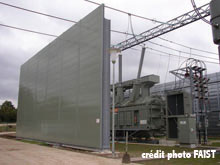
acoustical screen for environmental noise limitation |
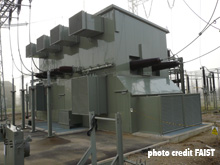
soundproof building for environmental noise limitation |
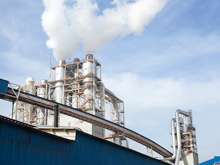
silencer for environmental noise limitation |
Taking into account the performance of different soundproofing materials, possibly with different scenarios, is an important step when carrying out an environmental noise study, in order to limit - in whole or in part - the sound impact of an industrial site.
The reduction of the sound power level, an intrinsic characteristic of noise sources, is what is commonly called noise reduction at the source; this solution causes (if one disregards the questions of directivity and a possible lack of homogeneity of the constituent elements which would create localized weaknesses, especially at short distance) a general limitation of the noise levels for the environment.
When it is a question of limiting the transmission of noise through an opening without opposing the passage of a fluid, a silencer is a common solution:
- wether vent (discharge) silencers for pressurized gas
- whether silencers for exhaust gases from reciprocating internal combustion engines or exhaust silencers for gas turbines i.e. combustion turbines, or silencers for industrial chimneys (stacks)
- whether it is for process air intake e.g. air intake silencers for gas turbines i.e. combustion turbines
- whether silencers for ventilation - suction or discharge openings -
In other cases, a construction enveloping the noise source (with walls, roof, and in some cases: floor) can be considered (depending on the case: machine casing, canopy, enclosure or soundproof building) with:
The alternative to noise reduction at the source is the implementation of obstacles on the path of sound waves (between noise source and specified locations) that acoustical screens are.
This solution is distinguished by the fact that its effectiveness is variable according to the combination of the respective particular positions of the sound emission (the noise source) and of the receiver (point to be protected from the noise) with respect to each acoustic screen (whose dimensions and constitution also matter, as does the possible presence of sound-reflecting surfaces at each end of the sound wave path).
In practice, such noise barriers are usually made like the vertical walls of the canopies, enclosures and soundproof buildings mentioned above.
Their basic characteristics are:
- the sound absorption coefficient (in % i.e. from 0 to 1 except when measured in a reverberation room, the Sabine factor may be higher) illustrating the ability not to reflect sound waves (what, on the side of the source of noise would be counterproductive, since it would lead to higher ambient sound levels)
- the sound reduction index (in dB) illustrating the capacity to oppose the transmission of sounds (the performance of the screen, based on the diffraction effect, must not be reduced by the propagation of noise through the wall constituting the obstacle)
Sizing, i.e. selection of products and construction systems appropriate to a given performance objective (in terms of acoustics, and also, with regard to silencers, in terms of aeraulics i.e. aerodynamics) that ITS can carry out is a key step in a environmental noise study, e.g. for the purpose of limiting noise emissions or their impact for local residents.
The human resource usually assigned by ITS to such tasks has a training in building physics, and a solid experience in construction technology, in relation to various noise reduction projects, for a reliable diagnosis and for the development noise control solutions meeting all the constraints of each project.
Examine the advantages and disadvantages of different noise reduction solutions with regard to the environmental impact of different noisy equipment and facilities on an industrial site, and propose the most appropriate improvements with respect to varied criteria (technical, regulatory, economic), with a reliable assessment of their effectiveness is what can be expected from a study entrusted to ITS, which markets various soundproofing devices (components and systems) for many applications in all sectors of activity.
Choice soundscapes, everywhere. This is the slogan of ITS.
Spread the word !
